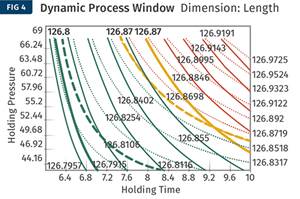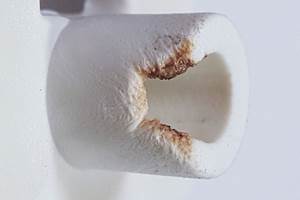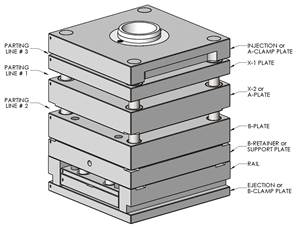Molder & Moldmaker Embraces Minimalist Tooling Philosophy
RenyMed’s niche consists of projects where it can offer not only molding, but help in designing and making the unique, compact, modular tools that are a company specialty.
RenyMed CEO Steve Raiken half-jokingly calls it his “Harry Potter closet.” The walls of the 6 x 8 ft space off the tool room are lined with shelves filled with small plastic containers. They give the initial impression that this is a compact storage area for various mold components. On closer inspection, however, visitors discover that each blue plastic container holds a production tool slid into protective netting.
For most injection molders, tool storage consists of pallet-lined floor-to-ceiling racks, where molds are moved to and from production by a combination of forklifts and overhead cranes. However, RenyMed, Baldwin Park, Calif., can store all its tooling in what amounts to a closet, with workers pulling a mold from its netting and dropping it into the appropriate modular base, which RenyMed also makes.
Says Raiken, “When we tell a potential customer we have a unique modular system, almost always they ask, ‘Is it a M.U.D. base?’ We show them 4-in. round cavity mold insert set with a robust 1/2-in. cooling channel that envelops the cavity, double slides that inter- lock the cavity, a side Y-corepull, and a helical unwind for a luer thread.
“We then install all this in a mold base with guided ejection and it becomes an SPI class 101 mold without an ejector pin mark on the part. The customer then says they have never seen a solution such as this. We then tell them this is scalable to four cavities. This is unique.” This modular tooling concept was developed by RenyMed about seven years ago. While it’s not a fit for every project, in the programs where it does work, it offers myriad benefits. In addition to shorter lead times, the compact tools require minimal storage space and can run on smaller machines. Those floorspace-saving benefits add up quickly in the costly California real-estate market.
From a production standpoint, the compact tooling minimizes residence time for the expensive, heat-sensitive resins RenyMed uses to mold precision medical components.
“Because it’s modular, we’re starting from the 40-yard line in terms of design,” says Raiken. “We’re getting a running start on the project.” As an example, he displays one part for which RenyMed was able to create tools for six different sizes in seven weeks.
“We make the most contained and concise mold,” Raiken says. “So, when we use this tooling, what we’re doing is asking, ‘What does the part require?’ rather than fitting the part into something we know.”
Raiken knows molds, having started a one-man tool shop in the mid-1980s after completing a moldmaking apprenticeship. That operation was carved out of unused space in the corner of an injection molder, and consisted of a mill, grinder, and lathe. Dissatisfied with the mold testing he was finding, Raiken decided to add a molding machine, which he did in a new space all to himself.
Raiken expanded his 911±¬ÁĎÍř from there, taking on molding and growing along with the California medical-device market, which called for high-precision parts made from difficult materials in a race to the smallest that continues today. Ten years ago, RenyMed moved into its current space in Baldwin Park.
Raiken notes that most of the parts he makes weigh less than a gram. Exemplifying the small size and precise nature of the programs RenyMed takes on, when Plastics Technology visited, Raiken was preparing for a customer visit to discuss a new ophthalmology product used to hold the iris open during cataract surgery. For this project, as with well over 90% of its jobs, RenyMed will help design the tooling it will build and run.
“Our niche is creative DFM [design for manufacturing]. We provide our customers with creative manufacturing solutions that help them realize their medical device,” Raiken says. “At trade shows, molders lay out hundreds of parts, to say, ‘That’s what we do, we make plastic parts.’ Well that’s not what we do. We provide our customers with the ability to make their product.”
Related Content
A Systematic Approach to Process Development
The path to a no-baby-sitting injection molding process is paved with data and can be found by following certain steps.
Read MoreOptimizing Pack & Hold Times for Hot-Runner & Valve-Gated Molds
Using scientific procedures will help you put an end to all that time-consuming trial and error. Part 1 of 2.
Read MoreBack to Basics on Mold Venting (Part 1)
Here’s what you need to know to improve the quality of your parts and to protect your molds.
Read MoreHow to Design Three-Plate Molds, Part 1
There are many things to consider, and paying attention to the details can help avoid machine downtime and higher maintenance costs, and keep the customer happy.
Read MoreRead Next
See Recyclers Close the Loop on Trade Show Production Scrap at NPE2024
A collaboration between show organizer PLASTICS, recycler CPR and size reduction experts WEIMA and Conair recovered and recycled all production scrap at NPE2024.
Read MoreFor PLASTICS' CEO Seaholm, NPE to Shine Light on Sustainability Successes
With advocacy, communication and sustainability as three main pillars, Seaholm leads a trade association to NPE that ‘is more active today than we have ever been.’
Read MoreLead the Conversation, Change the Conversation
Coverage of single-use plastics can be both misleading and demoralizing. Here are 10 tips for changing the perception of the plastics industry at your company and in your community.
Read More









